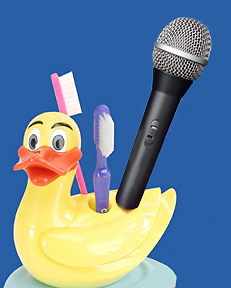You’ve finally invested in a high-quality vocal microphone and your voice has never sounded better.
Unfortunately, the keyboard player in your band decides he wants to use your mic during his featured rap. You cringe as he practically eats the microphone.
You can barely watch as he encourages audience members to scream into the mic.
Afterwards he returns your mic, still operational but considerably wetter and unhygienic.
Microphones are subject to an inordinate amount of abuse, especially in live music. Grilles and foam windscreens can become saturated with saliva, clogged with lipstick, and will absorb the smell of cigarette smoke prevalent in most clubs.
Regular cleaning of your microphone will not only improve its performance, but is also good hygiene. This document provides several simple yet effective techniques for cleaning microphones.
Dynamic Microphones
The best way to clean a microphone is to remove the grille. Most vocal microphone grilles simply unscrew, e.g., SM58, BG3.1. If the grille doesn’t slide off easily, gently rock it back and forth while pulling it away from the cartridge. Do not pull sharply or with excessive force, since that could damage the cartridge or separate it from the microphone housing.
Once the grille is removed, it can be thoroughly cleaned without damaging the mic. Since most of the offensive material on the grille comes from the human body, plain water should be a sufficient cleanser. Adding a mild detergent (dishwashing liquid) to the water will act as a mild disinfectant and remove odors absorbed by the foam windscreen.
To remove lipstick and other material stuck in the grille, use a toothbrush with soft bristles. In some models, the foam windscreen can be removed from the grille, but this is usually not necessary since water will not damage the grille. Most Shure microphone grilles have a nickel finish that makes them resistant to rust, and replacing the foam windscreen can also be difficult and time-consuming.
The most important thing to remember is: let the grille dry completely before reattaching it to the microphone! Microphones don’t like water, and although dynamic mics can withstand small amounts of moisture, a soggy foam windscreen will introduce more than is acceptable.
Air drying is the best way to dry the grille, but a hair drier on a low-heat setting can be used. Care must be taken not to get too close to the grille as excessive heat can melt some windscreen material.




















